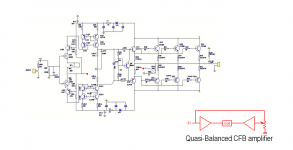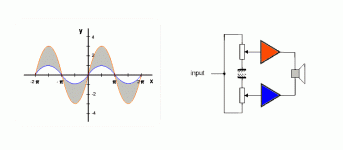The method allows the quasi-balanced amplifier with working conditions is optimized.
two amplifiers identical bridged generate power on the load when the second sees reduced the level of the input signal.
the minimum is still guaranteed by the internal feedback
two amplifiers identical bridged generate power on the load when the second sees reduced the level of the input signal.
the minimum is still guaranteed by the internal feedback
Attachments
And the answer is, none at all, in fact it has serious drawbacks. One amplifier sees completely different operating points within it's output stage SOA compared to the other. The one with reduced output is under considerably more strain, as the current through the output stage is dictated mostly by the oposing bridged amp, while the NFB reduces output voltage, meaning increases voltage drop on the output devices.
Just because it's different it does not mean it's a good idea. In fact, in all honesty, I have yet to see one from this author?
Just because it's different it does not mean it's a good idea. In fact, in all honesty, I have yet to see one from this author?
the gain of the bipolar devices is much higher than the power required for domestic use
this method can reduce the power output without reducing the optimal regimen of work
this method can reduce the power output without reducing the optimal regimen of work
- Status
- Not open for further replies.

